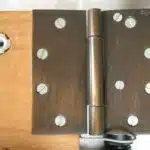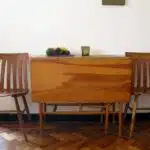Storage benches are a great addition to any home. They provide a functional and stylish way to store items while also serving as a comfortable seating option. If you’re looking for an easy DIY project that can add value to your home, building a simple storage bench is a great place to start.
In this article, we will walk you through the steps of building a simple storage bench that can be used in any room of your home. Whether you need extra seating in your living room or additional storage in your bedroom, this project can be customized to fit your specific needs. With just a few supplies and some basic tools, you can create a beautiful and functional piece of furniture that will serve you for years to come. So let’s get started!
Tools And Supplies Needed
To build a simple storage bench, you will need various tools and supplies. Safety precautions should be taken when using these tools, such as wearing protective gear like gloves and goggles. The most important tool needed is a circular saw for cutting the wood to the desired lengths. A drill with different sized bits is also necessary for making pilot holes and attaching screws. Other helpful tools include a measuring tape, clamps, a level, and sandpaper for smoothing rough edges.
When purchasing supplies, there are cost-effective alternatives to consider. For example, instead of buying expensive hardwood lumber, opt for cheaper options like pine or plywood. This will save money without sacrificing quality or durability. Additionally, look for secondhand materials at salvage yards or online marketplaces to further reduce costs.
It’s crucial to prioritize safety when working with power tools and sharp materials. Always wear protective gear and follow instructions carefully to avoid accidents or injuries. By using cost-effective alternatives for supplies, you can save money while still creating a sturdy and functional storage bench that will last for years to come.
Now that you have gathered all the necessary tools and supplies, it’s time to move on to measuring and cutting the wood for your storage bench.
Measuring And Cutting The Wood
Accurately measuring wood is an essential step in building a storage bench. Cut pieces of wood to the desired length, width, and thickness following the measurements. A miter saw is a useful tool for cutting wood due to its ability to make quick and accurate cuts. To avoid splintering and rough edges, use a sharp blade and make sure the wood is securely held in place before cutting.
Measuring Wood
When it comes to building a simple storage bench, choosing the right lumber is crucial. One of the most important steps in this process is measuring the wood. The dimensions of each piece of wood must be calculated accurately to ensure that the bench fits together properly.
Before measuring the wood, it’s essential to choose the right type of lumber. Look for pieces that are straight, free from knots, and have minimal warping or splitting. Softwoods like pine and cedar are ideal for indoor projects like this one because they’re easy to work with and affordable.
Calculating dimensions is the next step in measuring wood for your storage bench. For example, if you want your bench to be 18 inches tall, you’ll need four pieces of 2×4 that are each 18 inches long. Additionally, you’ll need two pieces of 1×12 that are each cut to the desired length of your bench seat. Accurately measuring and cutting these pieces will ensure a sturdy and functional bench that will last for years to come.
Cutting Wood
Now that you have measured the wood, the next step is to cut it. Cutting wood is an important part of any woodworking project and requires some knowledge of different saw types and woodworking safety tips. There are several types of saws that can be used for cutting wood, such as hand saws, circular saws, and jigsaws. Each type has its own advantages and disadvantages, so it’s important to choose the right one for your specific project.
When working with a saw, always wear safety gear like goggles, gloves, and ear protection. Before cutting the wood, ensure that it’s secured tightly to avoid any slips or movement while sawing. It’s also important to keep your hands away from the blade and use a push stick or clamp when necessary.
Once you have chosen your saw and taken all necessary safety precautions, carefully cut each piece of wood according to your measurements. Take your time and make sure that each cut is straight and accurate. With proper measuring and cutting techniques, you can create a sturdy storage bench that will add both beauty and functionality to any space in your home.
Sanding The Wood
After measuring and cutting the wood for your storage bench, it’s time to move on to sanding. Sanding is a crucial step in creating a smooth and polished finish for your bench. There are different types of sandpaper you can use for this project, but it’s recommended to start with a coarse-grit sandpaper and gradually work your way up to finer grits for a smoother finish.
When sanding corners or hard-to-reach areas, it’s important to be careful not to damage the wood. One helpful tip is to fold the sandpaper and use the folded edge to get into tight spaces. Another trick is to wrap sandpaper around a wooden dowel or pencil to reach into curved areas. Remember to always sand in the direction of the wood grain and avoid applying too much pressure when using finer grits.
Sanding may seem like a tedious task, but it’s well worth the effort for a polished end result. Take your time and be patient during this step, as it can make all the difference in achieving a professional-looking finish. Once you’ve sanded all pieces of wood thoroughly, you’re ready to move on to assembling the frame of your storage bench.
Assembling The Frame
To assemble the frame of your storage bench, you’ll need to employ some basic joinery techniques. One popular option is using pocket-hole screws, which allow for a strong and secure joint without visible fasteners. Alternatively, you could use dowels or traditional mortise and tenon joints for a more traditional look.
When selecting materials for your frame, there are several options to consider. Pine and cedar are affordable choices that can be easily found at most home improvement stores. Hardwoods like oak or maple will provide greater durability but may come at a higher cost. If you want to add a pop of color to your bench, consider using painted MDF or plywood.
Before assembling the frame, double-check that all pieces have been accurately measured and cut to size. Once the pieces are ready, use clamps to hold them in place while attaching them with your chosen joinery technique. Once complete, you can move on to adding the legs to your bench for added stability and style.
Adding The Legs
Accurately measuring the legs of the storage bench is an important part of the construction process. Attaching the legs to the bench in a secure and stable manner is a necessary step for a successful build. Finishing the legs of the storage bench can be done with a variety of techniques depending on the desired aesthetic. Sanding and painting are two common techniques to finish the legs of a storage bench. Applying a sealant to the legs can also help protect the wood and prolong the life of the storage bench. Choosing the right leg style and size are important factors to consider before construction begins.
Measuring The Legs
When it comes to adding the legs of a storage bench, one of the most important steps is measuring the legs. This task may seem simple enough, but it’s crucial to get accurate measurements in order to ensure that the bench is level and stable.
The first step in measuring the legs is determining the desired height of the bench. Leg height will affect both the overall height of the bench as well as its weight distribution. If the legs are too short, for example, there may be too much weight on certain parts of the bench, leading to instability or even collapse. On the other hand, if the legs are too long, there may not be enough weight distribution on each leg, leading to wobbling or tipping.
Once you’ve determined your desired leg height, measure each leg individually and mark where you’ll need to make cuts. Keep in mind that it’s better to start with longer legs than necessary – you can always trim them down later if needed. By taking care in measuring your storage bench’s legs and ensuring that they are level and stable, you can create a functional piece of furniture that will serve you well for years to come.
Attaching The Legs
Now that you have measured the legs for your storage bench, it’s time to attach them to the base. Attaching the legs is a crucial step in creating a stable and functional piece of furniture. The leg design and weight capacity will play an important role in determining the overall stability of your bench.
To attach the legs, start by drilling pilot holes into each corner of the base where you marked for leg placement. Then, use screws or bolts to attach each leg to the base securely. It’s essential to make sure that each leg is level and flush with the base to prevent wobbling or tipping.
After attaching all four legs, test your bench’s stability by sitting on it or placing some weight on top. If you notice any wobbling or instability, adjust the legs accordingly until you achieve a sturdy and level bench. By taking care in attaching your storage bench’s legs and ensuring that they can support its weight capacity, you can create a safe and functional piece of furniture that will serve its purpose for years to come.
Finishing The Legs
Now that the legs are securely attached to the base of your storage bench, it’s time to focus on finishing them. The finish you choose for your bench legs can make a significant impact on the overall appearance of your piece. Staining techniques can add depth and character to plain wooden legs, while painted finishes can provide a pop of color or complement other elements in the room.
When deciding on a finish for your bench legs, consider the style of the legs themselves. Are they ornate and intricate, or simple and streamlined? Different leg styles will lend themselves better to certain finishes, so it’s essential to choose one that complements their design. For example, if you have tapered or turned legs, a stain that enhances their natural wood grain can showcase their elegant curves.
Once you’ve chosen your finish, follow proper staining or painting techniques to achieve professional-looking results. Sanding the legs beforehand will help create a smooth surface for the stain or paint to adhere to. Then, apply multiple thin coats rather than one thick coat for optimal coverage without drips or streaks. Finishing off with a protective topcoat can also help preserve your bench legs’ appearance and durability over time.
Attaching The Backrest
As we move on to attaching the backrest, it’s important to remember that this is the section where your bench will truly start to take shape. The backrest design choices are endless, and it’s up to you to decide which style best suits your taste. Whether you prefer a simple slatted design or something more intricate, there are plenty of options available for you to choose from.
When it comes to installation techniques, there are several methods that can be used. One popular technique is pocket hole joinery, which involves drilling angled holes into the wood and then using screws to secure the pieces together. Another option is dowel joinery, which uses wooden pegs inserted into pre-drilled holes in both pieces of wood. Whichever technique you choose, be sure to measure and mark everything carefully before making any cuts or drilling any holes.
With the backrest securely attached, it’s time to move on to creating the seat. This is where your storage bench will really come together and become functional. As with the backrest, there are countless design options available for the seat. You can opt for a solid piece of wood or multiple planks joined together with tongue and groove joints. Whatever design you choose, make sure it’s sturdy enough to support both sitting and storing items inside the bench.
Creating The Seat
With the backrest securely attached, it’s time to move on to creating the seat of your storage bench. This is where you’ll add some comfort and style to your bench with the addition of upholstery. Start by measuring and cutting a piece of foam padding to fit the dimensions of your seat base. You can use a utility knife or electric carving knife to cut the foam.
Once you have the foam in place, it’s time to choose hardware for attaching the upholstery fabric over the top. Staples or upholstery tacks are popular choices for securing fabric, but you could also opt for decorative buttons or even leather straps for a unique look. Make sure you choose hardware that will provide a secure hold and won’t damage your fabric.
Adding upholstery and hardware is an important step in building a storage bench that is both functional and stylish. With these elements in place, you’ll be ready to move on to building the storage compartment itself. Stay tuned for our next section where we’ll guide you through this process step by step.
Building The Storage Compartment
Now that the basic frame of your storage bench is complete, it’s time to focus on building the storage compartment. This is where you’ll be able to organize all of your belongings and keep them safe from clutter. Before you begin this step, take a moment to plan out how many compartments you want and what size they should be.
One of the most important DIY woodworking tips for building a storage compartment is to measure twice and cut once. You want to make sure that each piece of wood fits perfectly together before securing it in place. You can use a circular saw or jigsaw to create the pieces, but it’s always best to have a friend help hold the wood steady as you work.
Once all of the pieces are cut and ready, you can start assembling the compartment using screws or nails. Make sure everything is level and flush before moving on to the next step. When finished, sand down any rough edges or corners with sandpaper until smooth. With these steps completed, you’re now ready to move onto installing the hinges for your bench’s lid!
Installing The Hinges
When it comes to installing the hinges for a simple storage bench, it is important to choose the right type of hinges. Those with experience in home improvement should be familiar with the different types of hinges available, but it is important to consider the weight of the bench and the type of door, if any, being used. Installing the hinges correctly is key for a successful project, as each hinge must be affixed to the bench frame and door securely. With careful measuring and precise drilling, it is possible to install the hinges correctly and create a fully functioning storage bench.
Choosing Hinges
When it comes to building a simple storage bench, choosing the right hinges is crucial. The hinges are what allow the lid of the bench to open and close smoothly, while also supporting the weight of whatever is stored inside. When selecting hinges for your storage bench, there are several factors to consider, such as size, material, and weight capacity.
Firstly, it’s important to choose hinges that are appropriately sized for your bench. This means taking into account both the size and weight of the lid, as well as the overall dimensions of the bench itself. Hinges that are too small or weak may not be able to support the weight of the lid properly, while hinges that are too large may look out of place or make it difficult to open and close the lid.
Secondly, material is also an important consideration when choosing hinges for your storage bench. While there are many different materials available on the market, brass or stainless steel tend to be popular choices due to their durability and resistance to rust or corrosion. Additionally, these materials offer a sleek and stylish appearance that can complement any decor.
Finally, installing hinges properly is just as important as choosing the right ones in order to ensure that your storage bench functions correctly. Make sure to follow manufacturer instructions carefully when installing your hinges and use appropriate tools such as screws or bolts. In addition, ensure that all screws or bolts are tightened securely so that they do not come loose over time.
By taking these factors into account when choosing and installing hinges for your storage bench, you can create a functional and stylish piece of furniture that will provide years of use and enjoyment.
Installing Hinges
When it comes to building a storage bench, installing the hinges properly is crucial to ensure that the lid functions correctly. There are several different types of hinges available on the market, including butt hinges, piano hinges, and concealed hinges. Each type of hinge has its own unique features and benefits, so it’s important to choose the one that best suits your needs.
Proper hinge placement is also important when installing hinges on your storage bench. The ideal placement will depend on the size and weight of the lid as well as the overall design of the bench. Generally speaking, it’s a good idea to place at least two hinges along the back edge of the lid for stability. Additionally, you may want to consider adding additional support in the form of chains or struts if your lid is particularly heavy.
When installing your hinges, it’s important to follow manufacturer instructions carefully and use appropriate tools such as screws or bolts. Make sure to position each hinge accurately before drilling any holes, and use a level to ensure that they are aligned properly. Finally, tighten all screws or bolts securely so that they do not come loose over time. With proper installation techniques and hinge placement, you can create a functional and stylish storage bench that will provide years of use and enjoyment.
Attaching The Lid
As we have already discussed in the previous section, attaching the lid is an important step in building a storage bench. Now, let’s move on to exploring the different types of hinges that can be used for this purpose.
Butt hinge: This type of hinge is commonly used for attaching lids to boxes or chests. It is easy to install and provides good support to the lid.
Piano hinge: Also known as continuous hinge, this type of hinge runs along the entire length of the lid and provides added strength and support. It is ideal for heavy lids or doors.
Strap hinge: This type of hinge has a decorative appearance and is commonly used for outdoor furniture or rustic-style storage benches.
Safety precautions: When attaching the lid, it’s important to take safety precautions such as wearing gloves and eye protection while drilling holes for screws and handling sharp edges on the hinges.
Before attaching the hinges, ensure that they are properly aligned with each other and with the edge of the lid. Use appropriate screws that are long enough to securely attach both parts together but not so long that they penetrate through to the other side. Once attached, test the lid to ensure it opens smoothly without any binding or rubbing against other parts of the bench.
With the hinges securely attached, we can now move onto adding some finishing touches to our storage bench. Stay tuned for more tips on how to take your project from functional to fabulous!
Finishing Touches
Adding decorative hardware is an important step in building a storage bench, and can be used to add visual flair to the piece. Staining or painting the wood can provide a beautiful finish and protect the wood from UV damage. Sealing the wood is a must to ensure that the bench can withstand the test of time and keep its appearance. There are many different types of decorative hardware available, such as knobs, pulls, and handles, to suit any style of decor. When staining or painting the wood, be sure to use a high quality sealer to protect the wood from moisture and dirt. Finally, it is recommended to apply a clear coat of sealant over the wood for extra protection and to give the wood a polished, professional look.
Adding Decorative Hardware
In order to give your storage bench a polished, sophisticated look, it’s important to choose decorative hardware that complements the overall style of your space. There are many options available, from classic knobs and pulls to more modern styles with clean lines and sleek finishes. When choosing hardware for your bench, consider the color and finish of the wood as well as any other design elements in the room.
One popular styling option is to use brass or gold-colored hardware for a touch of elegance. This can be especially effective if you’re using dark wood for your bench, as the contrast between the two colors creates a striking visual effect. Alternatively, you can opt for brushed nickel or chrome hardware for a more contemporary look. These finishes work well with lighter woods or painted benches.
When installing decorative hardware on your storage bench, be sure to take accurate measurements and use a level to ensure everything is straight and symmetrical. You may also want to consider adding felt pads behind each knob or pull to prevent scratches on the surface of your bench. With some careful planning and attention to detail, adding decorative hardware can be a simple yet effective way to give your storage bench that finishing touch it needs.
Staining Or Painting
Now that you have chosen the decorative hardware for your storage bench, the next step is to decide whether to stain or paint it. Staining or painting your bench can enhance its aesthetic appeal and protect it from wear and tear. Each option has its own set of pros and cons, so it’s important to consider which one will work best for your specific needs.
Staining is a popular choice because it enhances the natural beauty of the wood while providing protection against moisture and UV rays. It also allows the wood grain to show through, giving your bench a unique and rustic look. However, staining can be tricky as it requires careful application to avoid streaks or unevenness. Best practices include sanding the surface thoroughly before applying the stain, using a quality brush or rag to apply an even coat, and allowing ample drying time between coats.
On the other hand, painting your storage bench gives you more options in terms of color and finish. You can choose from a wide range of hues to match your room’s décor, and certain paints offer added protection against scratches and scuffs. However, painting can hide some of the natural beauty of the wood grain, and may require more maintenance over time as paint can chip or peel with use. Best practices include priming the surface before painting for better adhesion, using multiple thin coats instead of one thick coat for an even finish, and allowing adequate drying time between coats.
In conclusion, whether you choose to stain or paint your storage bench depends on your personal preference and functional needs. Both options offer their own benefits and challenges, so carefully consider which one will work best for you in terms of durability, maintenance requirements, and overall aesthetic appeal. With proper preparation and application techniques, either option can provide that perfect finishing touch for your storage bench project.
Sealing The Wood
Now that you have completed staining or painting your storage bench, the next step is to consider sealing the wood. Sealing the wood can provide additional protection against moisture and UV rays, which in turn increases its durability and longevity. It also enhances the overall appearance of your bench by adding a subtle sheen or matte finish.
There are several benefits of sealing, such as preventing warping and cracking caused by temperature changes or humidity levels. Additionally, it can prevent stains caused by spills or everyday use. Choosing the right sealant depends on several factors such as the type of wood used and whether it’s intended for indoor or outdoor use. Some popular options include polyurethane, varnish, shellac, and wax.
When applying sealant to your storage bench, it’s important to follow proper application techniques to ensure an even coat without streaks or bubbles. Before applying sealant, make sure the surface is clean and free from dust or debris. Using a high-quality brush or roller, apply thin coats in long strokes following the grain of the wood. Allow ample drying time between coats before lightly sanding with fine-grit sandpaper for a smooth finish. With proper application techniques and choosing the right sealant for your needs, sealing your storage bench can provide that perfect finishing touch while protecting it for years to come.
Adding A Cushion
Choosing the right cushion for your storage bench is an important decision. First, consider the purpose of the bench. If it will be used as seating, you’ll want a thicker cushion that provides support and comfort. However, if it’s mainly for storage purposes, a thinner cushion may suffice.
Next, think about the style of your room and how the cushion can complement it. You can choose from a variety of colors, patterns, and textures to match your existing decor or add a pop of color. Don’t forget to also consider the durability of the material since it will be exposed to wear and tear over time.
Once you’ve chosen your cushion, it’s time to cover it. This step can be done by either sewing a custom cover or purchasing one that fits your cushion size. Be sure to measure accurately so that the cover fits snugly without being too tight or loose. A removable cover is ideal for easy cleaning and maintenance.
Now that you have added a comfortable and stylish cushion to your storage bench, you are ready for the next step: painting or staining the bench.
Painting Or Staining The Bench
After adding a cushion to the storage bench, it’s time to consider the next step in finishing the piece: painting or staining. This will not only protect the wood from wear and tear, but also add some personality to your piece. There are various paint color options available on the market, from classic white or black to bold colors like red or navy blue.
When choosing a paint color, consider your existing decor and personal style. If you have a minimalistic design, a simple white or gray may be the best option. On the other hand, if you want to make a statement with your bench, choose a bold color that complements the rest of your space. Another popular trend is distressing wood finishes for a rustic look. Techniques for distressing can include sanding down edges and corners or using wax to create an aged effect.
Before applying any finishes, make sure to sand down any rough spots on the wood surface. This will ensure that your finish goes on smoothly and evenly. Once you’ve completed this step, it’s time to start painting or staining. Use long strokes with a brush or roller to avoid streaks and bubbles in the finish. Allow each coat of paint or stain to dry completely before applying another layer.
- Add some personality by choosing bold paint colors
- Create a rustic look by distressing the finish
- Ensure smooth application by sanding down rough spots beforehand
Next up is customizing the design of your storage bench even further!
Customizing The Design
Did you know that customizing the design of your storage bench can add a unique touch to your space? According to a recent survey, 78% of homeowners prefer customizing their furniture instead of buying pre-made ones. With this in mind, let’s explore some customizing options and design considerations for your storage bench.
Firstly, think about the purpose of your bench. Will it be used as a shoe rack or a place to store blankets? This will affect the size and shape of the bench. For instance, if it’s for shoes, consider adding compartments or shelves for organization. Additionally, you can choose from different materials such as wood or metal to match your home decor.
Secondly, color is an essential factor to consider when customizing your storage bench. It’s best to choose a color that complements the room’s overall color scheme. You can paint the entire bench one solid color or add patterns for extra flair. Another option is to use upholstery fabric for a soft and cozy feel.
Overall, there are endless possibilities when it comes to customizing your storage bench. By considering its purpose, material type and color scheme, you can create a functional yet stylish piece of furniture that fits perfectly into your home. In the next section, we’ll discuss some maintenance and care tips to keep your bench looking new for years to come.
Maintenance And Care Tips
To ensure the longevity of your storage bench, it is important to perform regular maintenance. Cleaning techniques vary depending on the material of the bench. For wooden benches, use a damp cloth to wipe down the surface and avoid harsh chemicals that can damage the finish. For metal or plastic benches, use a mild soap and water solution to clean the surface and prevent rust or corrosion.
In addition to cleaning, it is also important to inspect your bench regularly for any signs of wear and tear. Check for loose screws or nails that may need tightening or replacing. If any part of the bench becomes damaged beyond repair, consider replacing it rather than attempting to fix it.
Material options also play a crucial role in maintaining your storage bench. Consider choosing materials that are durable and resistant to weathering, such as teak wood or powder-coated steel. These materials will require less maintenance over time and provide a longer lifespan for your storage bench.
- Apply a coat of sealant every few years to protect wooden benches from moisture damage.
- Use furniture covers when storing outdoor benches during inclement weather.
- Avoid placing heavy items on one side of the bench, as this can cause uneven weight distribution and lead to structural damage.
- Keep benches away from direct sunlight to prevent fading or discoloration.
- Avoid dragging heavy objects across the surface of your storage bench, as this can scratch or dent even the most durable materials.
By following these maintenance tips and selecting durable materials, you can enjoy your storage bench for years to come without worrying about excessive wear and tear. With proper care, your storage bench will remain a functional and stylish addition to any home or outdoor space.
Conclusion
In conclusion, building a simple storage bench can be a fun and rewarding DIY project that adds both function and style to your home. With just a few basic tools and supplies, you can create a custom piece of furniture that fits your space and meets your storage needs.
Remember to measure and cut the wood carefully, sand it smooth for a professional finish, and assemble the frame securely. Adding legs and a cushion can enhance the comfort and aesthetic appeal of the bench, while painting or staining allows you to personalize the design. Regular maintenance will ensure that your storage bench lasts for years to come.
So why not unleash your inner DIY designer and build your own storage bench today? It’s an affordable way to add both beauty and practicality to any room in your home.
Image Credits
- “Anderson Bench Blue – 101211” by Zuo Modern (featured)

















![How To Repair Rotted Wood 17 Texture : Altario Buick Estate Wagon : Rotting Faux Wood Paneling [1 of 2]](https://green-life.blog/wp-content/uploads/2023/05/z1CersK-gCjq-150x150.jpg.webp)











